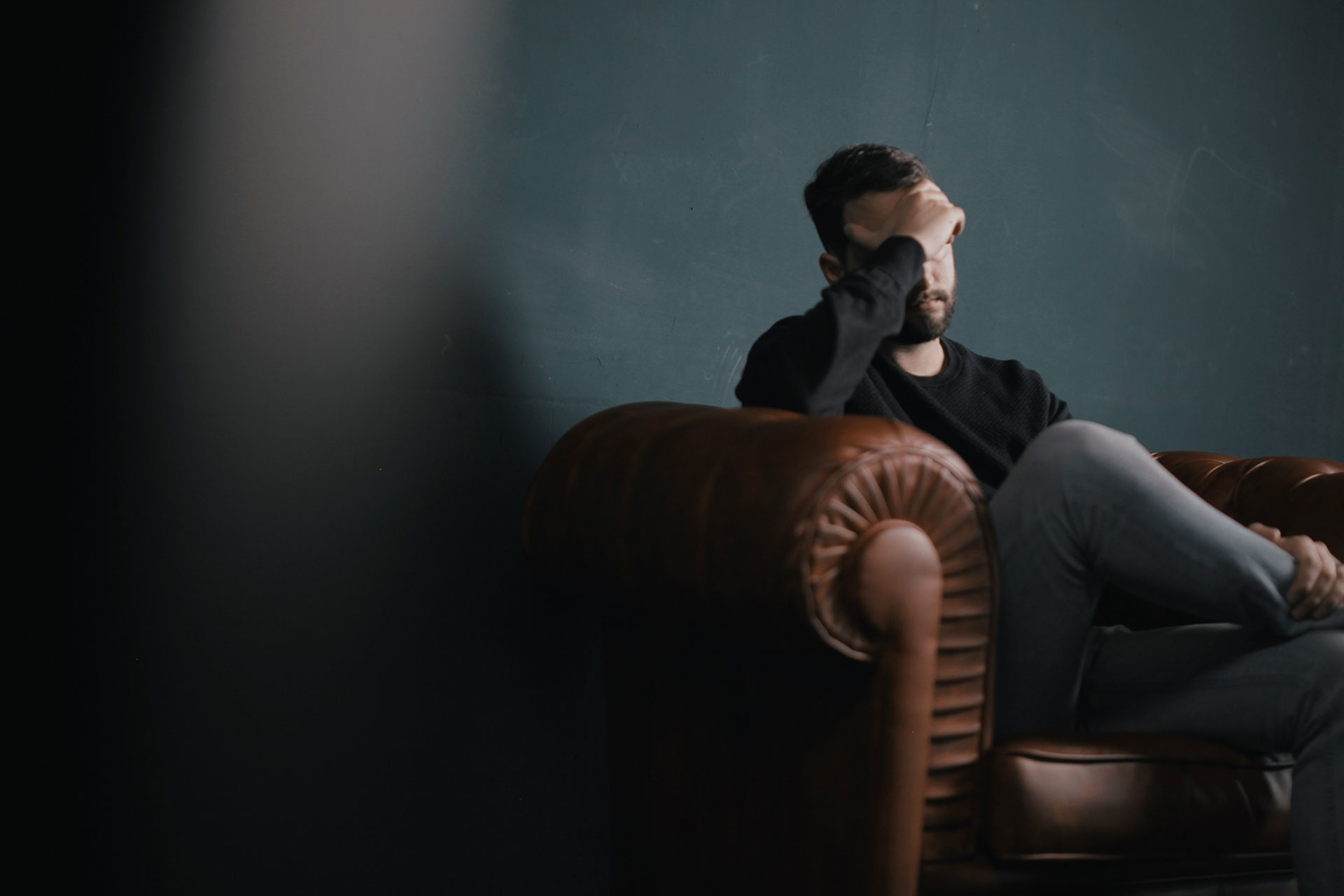You may find it strange to hear that anxiety is a surprisingly complex emotion with many possible causes and manifestations. If you’ve lived with anxiety for a long time and never asked yourself about it, it may seem like just the way you are, a simple state of being.
Anxiety is not our normal state, however. It has causes and symptoms that can be addressed, and can be reduced and managed over time. We don’t have to just accept it.
Physiology
Like pain, anxiety is intended to be a beneficial, healthy part of our normal function. You have probably heard of the “fight or flight” response. This is our sympathetic nervous system telling us what to do in a crisis.
 Imagine walking into a dark room in your basement. Out of the corner of your eye you catch a glimpse of an animal shape on a shelf at eye level, the perfect spot from which to pounce on unsuspecting prey. You hastily flip on the light and are greeted by the sight of your beloved stuffed teddy bear.
Imagine walking into a dark room in your basement. Out of the corner of your eye you catch a glimpse of an animal shape on a shelf at eye level, the perfect spot from which to pounce on unsuspecting prey. You hastily flip on the light and are greeted by the sight of your beloved stuffed teddy bear.
In that moment between the glimpse and flipping on the light, your body went into high alert, adrenaline and cortisol (stress hormone) pumping, readying your body to either run for it, or grapple with the beast to the death.
When the absence of a threat was revealed, the first thing you did was take a deep breath and blow it out. This signaled your parasympathetic nervous system to relax, to stand down from emergency status, and to chemically rebalance the system to a state of relative calm. This is why slow, deep breathing can be a great tool for reducing anxiety (flight) and anger (fight), which manifest almost identically in the body when activated.
One of the problems with trauma, especially when experienced as a child, is that the helpful wiring that allows us to remember hazards and avoid them, also etch traumatic events in our brain and store them in our body. This is why some people begin to cry without warning or have vivid memories of abuse come up during a massage. The body keeps the score. For some great reading on the subject, refer to the book of the same name by Bessel van der Kolk.
7 Common Anxiety Disorders
Many people suffer from one kind of anxiety or another. If you are beginning to wonder about your own, that’s good, but if it is disrupting your life, it is always a good idea to get a diagnosis from a professional. Each diagnosis has specific inclusions and exclusions based on severity, level of disruption, and time. The following are offered so you can begin to formulate some thinking around it before taking it up with your therapist.
Separation Anxiety Disorder

This is an age-inappropriate, excessive fear of separation from the people we are attached to emotionally. We may not cry and throw ourselves on the floor when the person leaves, but we may feel a high level of anxiety. If you have been told you are “clingy” or “too dependent,” this might be worth being curious about.
Selective Mutism
This is an inability to talk in situations where it is expected, like classes or meetings. Many people feel anxious about speaking in these situations. If you are unable to get the words out at all, this might be an interesting place to start with your therapist.
Specific Phobias
These are fears or anxieties associated with a particular object or situation, such as heights, flying, animals, insects, or the sight of blood. If you have anything that provokes sudden and intense fear or anxiety every time you are exposed to it, and the fear or anxiety is out of proportion to the actual threat posed, and especially if it is causing disruption in your work or home life, it would be worth wondering whether you might have a phobia.
Social Anxiety Disorder (Social Phobia)
This covers a broad range of anxieties associated with social interaction, where you might be exposed to scrutiny by others, including but not limited to public speaking, being seen eating or drinking, conversation, and meeting unfamiliar people.
If you have severe anxiety around these or other situations to the extent that you suffer significant distress or impairment in work or social or other important areas of function, this might be worth your curiosity.
Panic Disorder
This is pretty much what it sounds like: sweating, trembling, heart pounding or racing, shortness of breath, chest discomfort, feelings of choking, nausea or stomach ache, numbness or tingling, dizziness, feeling separated from reality or detached from self, fear of losing control, fear of dying.
It is important to note that many of these symptoms are indicators for something more severe. Depending on severity and location of symptoms, in the absence of a prior diagnosis, you should always either go to the ER or have yourself checked out by your physician. To be diagnosed with this disorder, it has to be recurrent and include four or more of the above symptoms.
Agoraphobia
This is often too simply defined as being afraid of going out doors. More accurately, this is a fear of being in open spaces (bridges, parking lots, other), or being in enclosed places (shops, theaters, other), using public transportation, standing in line, being in a crowd, or simply being outside the home alone (most common definition).

The anticipation of escalating anxiety keeps the sufferer from engaging the problem situations, or forces them to seek a companion to face them. As is common with phobias, the fear must be persistent, out of proportion to the actual threat, and cause significant impairment of work, social, or other important functioning.
As with other disorders, this may be caused by other physiological effects caused by substance use, or be a result of other disorders, so again, a professional diagnosis is important to ensure proper treatment.
Generalized Anxiety Disorder
This is the more common form of anxiety, experienced by most of the population at one time or another. For this diagnosis, three or more of the following are required: muscle tension, irritability, restlessness, feeling on edge, being easily fatigued, hard to concentrate, difficulty falling asleep, staying asleep or disrupted sleep. Symptoms must be causing significant impairment of work, social, or other functioning, and not be better explained by effects of substance use, or other disorders.
That covers most of the anxiety disorders listed in the diagnostic manual. As you can see, anxiety is a common and varied physiological response to a wide variety of stimuli. It can be indicative of a host of different disorders, which may or may not be affecting you. Again, please do not try to self-diagnose. If you are experiencing persistent and disruptive anxiety, seek the help of a psychologist or psychiatrist.
A Word about Substance Abuse
Most recreational substances carry the potential to trigger anxiety in users. If you are under the influence of any substance, including sedatives, opioids, alcohol and cannabis, really anything people take recreationally, you will have to stop long enough for the substance to pass out of your system before a professional can give you an accurate diagnosis.
Many mental health diagnoses include an exclusion saying the diagnosis may only be applied if the symptoms are not better explained by substance use. Substances can really muddy the waters of plausible diagnosis.
Treatment for Anxiety
Treatment for anxiety disorders is dependent upon both the severity and the duration of the symptoms. If you have had moderate to severe anxiety without a break for more than six months, it is not likely to respond initially to somatic treatments like deep breathing, mindfulness or single focus.
For severe, long-term anxiety, the most likely treatment is medication. When we allow anxiety to run unabated for so long, we actually rewire our brains, predisposing us to experience anxiety. The good news is we can rewire our brains. The same persistence over time of calming and mitigating our anxiety can gradually change this predisposition. This is where treatment comes in.
Medication
Pharmacological options for treating anxiety are many and varied, and some of them may also treat other disorders, like depression or bipolar disorder. Below is a list medicines used to treat anxiety, reprinted from another article. This is not a complete list.
Benzodiazepines
- alprazolam (Xanax) – panic, generalized anxiety, phobias, social anxiety, OCD
- clonazepam (Klonopin) – panic, generalized anxiety, phobias, social anxiety
- diazepam (Valium) – generalized anxiety, panic, phobias
- lorazepam (Ativan) – generalized anxiety, panic, phobias
- oxazepam (Serax) – generalized anxiety, phobias
- chlordiazepoxide (Librium) – generalized anxiety, phobias
Beta Blockers
- propranolol (Inderal) – social anxiety
- atenolol (Tenormin) – social anxiety
Tricyclic Antidepressants
- imipramine (Tofranil) – panic, depression, generalized anxiety, PTSD
- desipramine (Norpramin, Pertofrane and others) – panic, generalized anxiety, depression, PTSD
- nortriptyline (Aventyl or Pamelor) – panic, generalized anxiety, depression, PTSD
- amitriptyline (Elavil) – panic, generalized anxiety, depression, PTSD
- doxepin (Sinequan or Adapin) – panic, depression
- clomipramine (Anafranil) – panic, OCD, depression
Other Antidepressants
- trazodone (Desyrel) – depression, generalized anxiety
Monoamine Oxidase Inhibitors (MAOIs)
- phenelzine (Nardil) – panic, OCD, social anxiety, depression, generalized anxiety, PTSD
- tranylcypromine (Parnate) – panic, OCD, depression, generalized anxiety, PTSD
Selective Serotonin Reuptake Inhibitors (SSRIs)
- fluoxetine (Prozac) – OCD, depression, panic, social anxiety, PTSD, generalized anxiety
- fluvoxamine (Luvox) – OCD, depression, panic, social anxiety, PTSD, generalized anxiety
- sertraline (Zoloft) – OCD, depression, panic, social anxiety, PTSD, generalized anxiety
- paroxetine (Paxil) – OCD, depression, panic, social anxiety, PTSD, generalized anxiety
- escitalopram oxalate (Lexapro) – OCD, panic,depression, generalized anxiety, social anxiety, PTSD, generalized anxiety
- citalopram (Celexa) – depression, OCD, panic, PTSD, generalized anxiety
Serotonin-Norepinephrine Reuptake Inhibitors (SNRIS)
- venlafaxine (Effexor) – panic, OCD, depression, social anxiety, generalized anxiety
- venlafaxine XR (Effexor XR) – panic, OCD, depression, social anxiety, generalized anxiety
- duloxetine (Cymbalta) – generalized anxiety, social anxiety, panic, OCD
Mild Tranquilizer
- buspirone (BuSpar) – generalized anxiety, OCD, panic
Anticonvulsants
- Valproate (Depakote) – panic
- Pregabalin (Lyrica) – generalized anxiety disorder
Gabapentin (Neurontin) – generalized anxiety, social anxiety
Deep Breathing
If the anxiety is lower level or not as long-term, it may more easily respond to non-pharmacological methods, like deep breathing and mindfulness, or exercise. In actual practice, engaging your parasympathetic nervous system should reduce anxiety (or anger).
We do this with diaphragmatic deep breathing — breathing in through the nose and out through the mouth with our diaphragm (pushing the stomach out on our in breath). Entrenched anxiety will not usually respond quickly to deep breathing. If deep breathing helps you calm down, then do it. If it only contributes to your anxiety, let it go for now.
Mindfulness
 Another useful tool for managing anxiety, and a good one to do along with your breathing, is mindfulness, which is essentially locating yourself in your body in the present. Notice where you are feeling tight or tense and see if you can relax it.
Another useful tool for managing anxiety, and a good one to do along with your breathing, is mindfulness, which is essentially locating yourself in your body in the present. Notice where you are feeling tight or tense and see if you can relax it.
Usually, when we experience trauma, the first thing we do is disconnect from our body. Mindfulness is a way to reconnect, and help us become more integrated.
Psychodynamic Psychotherapy
This is where you explore with your therapist the traumatic narratives that have contributed to your emotional formation. Early trauma happens before we have the capacity to think about it, so we end up with frozen or “stuck” places where we can’t move.
As we begin to process our traumatic narrative, these stuck places have more room around them and are less easily triggered, reducing our overall anxiety over time. Think of your traumatic stories like covered furniture in the middle of your emotional room. Because you can’t see it, you keep running into it.
As you gain awareness around it, what you experienced, what you felt, and what you made up about it, you remove the sheets from the furniture and now the furniture has a place. It doesn’t go away, but you can stop running into it as often.
Most anxiety can be treated by some combination of medication, somatic techniques like deep breathing, and psychodynamic exploration of trauma narratives.
If you suffer from symptoms of anxiety, now may be the time to be kind to yourself and take the step of finding a therapist to get an accurate diagnosis, so you can begin to journey together toward growth and healing.
“Feeling Down,” courtesy of Patrick Denker, Flickr CreativeCommons (CC BY 2.0); “I love you,” courtesy of London Scout, unsplash.com, CC0 License; “Worried,” courtesy of Had Limcaco, unsplash.com, CC0 License; “Feet & Sunshine,” courtesy of Splitshire.com, CC0 License




